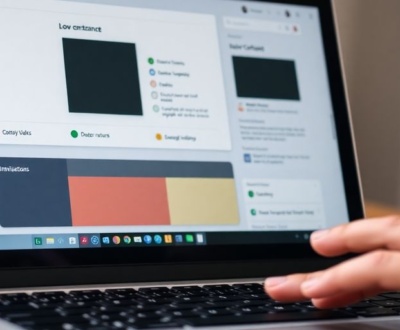Integrating Micro-Interactions into Web Design for a Seamless User Journey
- October 26, 2024
- Blog
Micro-interactions are tiny but powerful elements in web design that greatly enhance user experience. They help users understand how to interact with a website and provide instant feedback, making the whole process smoother and more enjoyable. This article explores how to effectively integrate micro-interactions into web design to create a seamless user journey.
Key Takeaways
- Micro-interactions are small design elements that enhance user engagement and provide immediate feedback.
- They can be triggered by user actions or automatically by the system, guiding users through their tasks.
- Effective micro-interactions improve user experience by making navigation easier and more intuitive.
- Consistency in micro-interactions helps reinforce brand identity and creates a cohesive user journey.
- Testing and gathering user feedback are essential for optimizing micro-interactions and ensuring they meet user needs.
Understanding Micro-Interactions in Web Design
Micro-interactions are small design elements that can greatly improve user experience on a website. They help users engage and navigate smoothly. These interactions usually consist of a trigger, like a user action, and feedback, which can be visual or auditory. They guide users through tasks and reinforce brand identity.
Definition and Importance
Micro-interactions are essential because they:
- Provide immediate feedback to users.
- Help users understand what actions they can take.
- Make the website feel more interactive and alive.
Types of Micro-Interactions
Micro-interactions can be categorized into two main types:
- User-triggered: These occur when users perform actions like clicking or scrolling.
- System-triggered: These happen automatically based on certain conditions, like a loading spinner.
Examples of Effective Micro-Interactions
Here are some great examples of micro-interactions:
- A button that changes color when hovered over.
- A notification sound when a message is received.
- A progress bar that fills up during a file upload.
| Type of Micro-Interaction | Example | Purpose |
|---|---|---|
| User-triggered | Button hover effect | Engages user |
| System-triggered | Loading spinner | Indicates process |
| User-triggered | Like button animation | Confirms action |
Micro-interactions guide users with intuitive cues in mobile apps and web design. They turn ordinary tasks into moments of delight when you do them well.
Understanding these small yet powerful elements can help create a more engaging and enjoyable user experience.
Enhancing User Engagement with Micro-Interactions
Role in User Engagement
Micro-interactions play a crucial role in enhancing user engagement. They are small design elements that provide feedback and guidance, making the user experience more enjoyable. Here are some key points about their role:
- Immediate Feedback: Users receive instant responses to their actions, which helps them feel connected to the interface.
- Encouragement to Interact: Micro-interactions can motivate users to engage more deeply with the content, like seeing a heart animation when they like a post.
- Error Prevention: They help users avoid mistakes by providing real-time validation, such as showing checks next to password requirements.
Impact on User Experience
The impact of micro-interactions on user experience is significant. They can:
- Make navigation easier by guiding users through tasks.
- Create a sense of trust and transparency, reducing frustration.
- Enhance brand personality, making the product feel more alive.
| Aspect | Effect on User Experience |
|---|---|
| Navigation | Easier and more intuitive |
| Trust | Builds confidence |
| Brand Personality | Creates emotional connection |
Micro-interactions are small but powerful elements that have a significant impact on user experience. They enhance user engagement, affordance, and trust.
Case Studies of Successful Implementations
Several companies have successfully integrated micro-interactions to boost user engagement. Here are a few examples:
- Facebook: The like button animation encourages users to interact with posts.
- Airbnb: Subtle animations guide users through the booking process, making it seamless.
- Slack: Notifications and typing indicators keep users informed and engaged during conversations.
By understanding and implementing micro-interactions, designers can create a more engaging and satisfying user experience.
Best Practices for Integrating Micro-Interactions
Aligning with User Goals
To effectively integrate micro-interactions, it’s crucial to understand user needs. Designers should identify where these interactions can be most beneficial. For instance, a small animation can help guide users through a tricky process, making their experience smoother and less frustrating.
Maintaining Consistency
Consistency is key in creating a seamless experience. If a specific action, like swiping left, always leads to the same result, users will feel more comfortable navigating the site. This predictability builds trust and enhances user satisfaction.
Ensuring Accessibility
Accessibility is vital. Micro-interactions should be designed to be perceivable by all users, including those with disabilities. Consider adding features like text descriptions or keyboard shortcuts to ensure everyone can engage with the interactions effectively.
Micro-interactions are small details with a big impact. Close collaboration with a developer is key to effectively integrating micro-interactions into your site’s design. Start by discussing the user experience to ensure alignment.
By following these best practices, designers can create micro-interactions that not only enhance user engagement but also contribute to a more enjoyable and accessible web experience.
Advanced Techniques for Implementing Micro-Interactions

Using Custom Designs
Creating unique micro-interactions can significantly enhance user experience. Custom designs allow for tailored feedback that resonates with users. Here are some ways to implement them:
- Use animation software like Adobe After Effects for intricate designs.
- Create visual cues that match your brand’s style.
- Test different designs to see which ones engage users the most.
Incorporating Voice and Haptic Feedback
As technology evolves, integrating voice and haptic feedback into micro-interactions is becoming essential. This can make interactions more engaging and intuitive. Consider these points:
- Voice commands can trigger specific actions, enhancing usability.
- Haptic feedback, like vibrations, can confirm user actions, providing reassurance.
- Combining both can create a seamless experience, especially in mobile apps.
Leveraging Animation Libraries and Frameworks
Using pre-built animation libraries can save time and ensure consistency across your design. Here are some popular options:
- Animate.css: Offers a variety of animations that can be easily integrated.
- GreenSock (GSAP): Provides advanced animation capabilities for more complex interactions.
- Lottie: Allows for high-quality animations that are lightweight and easy to implement.
Micro-interactions are not just about aesthetics; they are crucial for guiding users and enhancing their journey. By focusing on these advanced techniques, designers can create more engaging and effective web experiences.
Incorporating these advanced techniques can lead to a more engaging user experience, making interactions feel more intuitive and enjoyable. By focusing on custom designs, voice feedback, and animation libraries, designers can elevate their web projects to new heights. Remember, the goal is to create a seamless user journey that delights and engages users.
Testing and Optimizing Micro-Interactions

Importance of User Feedback
Gathering user feedback is essential for understanding how micro-interactions are perceived. This feedback helps identify what works well and what needs improvement. Here are some key points to consider:
- Identify pain points: Users can highlight areas where they struggle.
- Spot opportunities: Feedback can reveal new ideas for enhancing interactions.
- Validate designs: Ensure that the micro-interactions meet user expectations.
Conducting User Testing
User testing is a crucial step in optimizing micro-interactions. It allows designers to observe real user behavior and gather data. Here’s how to conduct effective user testing:
- Set clear goals: Know what you want to learn from the testing.
- Choose the right participants: Select users who represent your target audience.
- Observe interactions: Watch how users engage with the micro-interactions.
Iterating Based on Data
After collecting feedback and data, it’s time to make changes. Iteration is key to refining micro-interactions. Consider the following:
- Analyze user behavior: Look for patterns in how users interact.
- Make adjustments: Tweak designs based on user insights.
- Test again: Repeat the process to ensure improvements are effective.
Micro-interactions are not just small details; they can significantly impact user experience. By testing and optimizing them, you can create a more engaging and intuitive interface.
| Aspect | Importance |
|---|---|
| User Feedback | Identifies pain points and opportunities |
| User Testing | Validates designs in real-world scenarios |
| Iteration | Refines interactions based on data |
Future Trends in Micro-Interactions
Personalization with AI and Machine Learning
The future of micro-interactions is set to be shaped by personalization through AI and machine learning. These technologies will allow micro-interactions to adapt to individual user preferences, making experiences more relevant and engaging. For instance, a website could change its feedback animations based on a user’s past behavior, creating a tailored experience.
Integration with Emerging Technologies
Emerging technologies like augmented reality (AR) and voice-activated systems are opening new doors for micro-interactions. AR can create immersive environments, while voice interactions can provide hands-free experiences. This integration will enhance user engagement by making interactions more intuitive and enjoyable.
Predictions for the Future of Web Design
As we look ahead, several trends are expected to dominate the landscape of micro-interactions:
- Haptic feedback: This tactile sensation will add a new layer to user interactions, making them more immersive.
- Emotional design: Micro-interactions will increasingly focus on evoking emotions, creating memorable experiences.
- Guided actions: Advanced micro-interactions will help users navigate tasks more smoothly, reducing confusion.
The future of micro-interactions promises to create more engaging and immersive experiences, enhancing user satisfaction and trust.
Conclusion
In summary, using micro-interactions in web design is essential for creating a better user experience. These small design features help users feel more connected and engaged with a website. They provide quick feedback, guide users through tasks, and make the overall experience more enjoyable. By understanding how to effectively use micro-interactions, designers can improve user engagement and satisfaction. As technology continues to change, staying updated on new trends and tools will help designers create even more engaging experiences. Embracing the power of micro-interactions can truly elevate web design and enhance the way users interact with digital products.
Frequently Asked Questions
What are micro-interactions in web design?
Micro-interactions are small design features that help users interact with a website. They include things like animations or feedback that show users what is happening when they click a button or fill out a form.
Why are micro-interactions important for user engagement?
Micro-interactions keep users interested and engaged. They make the website feel more interactive, which can lead to longer visits and more actions taken by users.
How can I integrate micro-interactions into my website?
To add micro-interactions, think about where users will need feedback or guidance. Make sure these interactions are quick and visually appealing so they enhance the user experience.
What are some examples of effective micro-interactions?
Examples include a button changing color when you hover over it, a loading spinner while content is being fetched, or a small animation confirming an action like a successful form submission.
How do I ensure my micro-interactions are accessible?
Make sure your micro-interactions can be understood by everyone. This can include adding text descriptions or using color combinations that are easy to see for people with color blindness.
What future trends should I watch for in micro-interactions?
Look for trends like personalized experiences using AI, more use of voice commands, and new technologies that enhance how users interact with websites.
About this blog
We are a digital marketing company with a focus on helping our customers achieve great results across several key areas.
Request a free quote
We offer professional SEO services that help websites increase their organic search score drastically in order to compete for the highest rankings even when it comes to highly competitive keywords.









